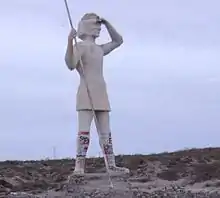Indio Comahue Monument
The Monumento al Indio Comahue (Monument to the Comahue Indian) is a monument located in Villa Regina, in the Argentine province of Río Negro. It was constructed to honor the native inhabitants of the Comahue Region. The monument was completed in time for the inaugural Comahue National Fair in 1964.
| Monumento al Indio Comahue | |
 | |
| Coordinates | 39°5′27.64″S 67°4′40.11″W |
|---|---|
| Location | Villa Regina, Río Negro, Argentina |
| Designer | Miguel de Lisi |
| Material | Reinforced concrete, ceramic brick, iron |
| Height | 12.92 metres (42.4 ft) |
| Beginning date | July 1964 |
| Completion date | September 1964 |
| Opening date | November 7, 1964 |
| Dedicated to | Native inhabitants of the Comahue |
Commissioned by the organizers of the fair, Bartolo Pasin and Rogelio Chimenti, it was designed by Miguel De Lisi and constructed in two months by local bricklayer Aldo Cardozo. Presently it is used as an overlook for its panoramic view. The monument is considered to be a symbol of the town, and as such it is depicted in the coat of arms.
History
The monument was erected to commemorate the native inhabitants of Comahue.[1] It was constructed for the first Comahue National Fair,[2] in 1964. This was a 45-day event that aimed to highlight the economic potential of the Comahue Region, and at the same time commemorate the 40th anniversary of the founding of Villa Regina. Bartolo Pasin and Rogelio Chimenti, who organized the fair, proposed the construction to designer Miguel De Lisi, after seeing his work at the City Hotel in Mar del Plata.[3]
Construction

De Lisi sent the drawings to the local construction team, led by Aldo Humberto Cardozo and Alberto Sartor. The monument had been originally planned to be 10 metres (33 ft) tall, but Cardozo re-scaled it to be nearly 11 metres (36 ft), and later also added a high base of 2 metres (6 ft 7 in).[3] The completed monument, now standing at almost 13 metres (42.4 ft), depicts a native who is holding a long spear while watching the horizon.[2]
Work started in July 1964, with the structure being built of reinforced concrete. It had an iron skeleton made up of 4 inch pipes (100mm), which was reinforced with radial sections that were soldered every 50 centimetres (20 in). Later, the figure was filled from the feet to the hips with ceramic brick and concrete, with the top half finished using a layer of reinforced concrete. The monument was completed in two months with an estimated weight of 80 tons, and a height of 12.90 metres (42.3 ft). In its construction, five hundred bags of cement, 2,500 kilograms (5,500 lb) of iron, 60 metres (200 ft) of steel, and 80 square metres (860 sq ft) of sand were used.[4]

It was later painted by a local man, Carlos Basabe Cerdá. The job proved to be very difficult due to strong winds that blew the wooden planks off the scaffolding and into a nearby ditch. A construction team later tied on the planks, solving the problem. The painters first applied a primer coat, then linseed oil, varnish, and finally a coat of copper glitter.[2] The monument was inaugurated during the opening of the Comahue National Fair on September 7, 1964.[4]
The monument and Villa Regina
The structure is located on the northern hill of the town, which has an elevation of 70 to 80 metres (230 to 260 feet). The hill is mostly covered in bushes and can be accessed by two paths.[1] Currently it is used as an overlook for its panoramic view of the town.[3] It also serves to mark the finishing line for the annual trekking trail competition, Desafío al Indio Comahue.[5]
Considered as the symbol of Villa Regina, the Indio Comahue is depicted in the city's coat of arms.[4] It was also depicted in the previous seal of the Río Negro Province,[6] designed by the government of the Argentine Revolution. The seal was replaced in 2009 by the one that the overthrown government designed in 1966, months before the coup d'état.[7] The Comahue National Fair was relaunched in 2004, and is currently celebrated every two years.[8]
Footnotes
- Automóvil Club Argentino 2004, p. 268.
- YPF 1998, p. 96.
- Zanini, Silvia Laura 2006, p. 432.
- Zanini, Silvia Laura 2006, p. 433.
- Río Negro staff 2013.
- Río Negro staff 2004.
- Al Día staff 2009.
- Feria del Comahue staff 2008.
References
- Al Día staff (2009). "Río Negro con nuevo escudo oficial" [Río Negro, with a new official seal]. Al Dia Newspaper (in Spanish). Diario Al Día.com.ar. Archived from the original on December 30, 2012. Retrieved March 19, 2013.CS1 maint: ref=harv (link)
- Automóvil Club Argentino (2004). Guía Turística Argentina [Argentine Touristic Guide] (in Spanish). Automóvil Club Argentino. ISBN 978-987-529-046-4.CS1 maint: ref=harv (link)
- Feria del Comahue staff (2008). "Historia" [History]. Feria Nacional del Comahue (in Spanish). Rio Negro Provincial Government. Archived from the original on March 3, 2016. Retrieved August 6, 2013.CS1 maint: ref=harv (link)
- Río Negro staff (2004). "Cuarenta años después, reeditan la Feria del Comahue en Regina" [Forty years later, the Comahue Fair is relaunched in Regina]. Rio Negro.com.ar (in Spanish). Diario Rio Negro. Retrieved March 19, 2013.CS1 maint: ref=harv (link)
- Río Negro staff (2013). "Desafío al Indio Comahue" [Comahue Indian Challenge]. Rio Negro.com.ar (in Spanish). Diario Rio Negro. Retrieved August 6, 2013.CS1 maint: ref=harv (link)
- YPF (1998). Patagonia y Antártida Argentina: Guía Turística [Patagonia and Argentine Antarctica: Tourist Guide] (in Spanish). Editorial San Telmo. ISBN 978-987-93-1004-5.CS1 maint: ref=harv (link)
- Zanini, Silvia Laura (2006). Las historias que nos unen : una perla junto a la barda [The stories that unite us: A pearl next to the hill] (in Spanish). ISBN 978-987-05-1868-6.CS1 maint: ref=harv (link)